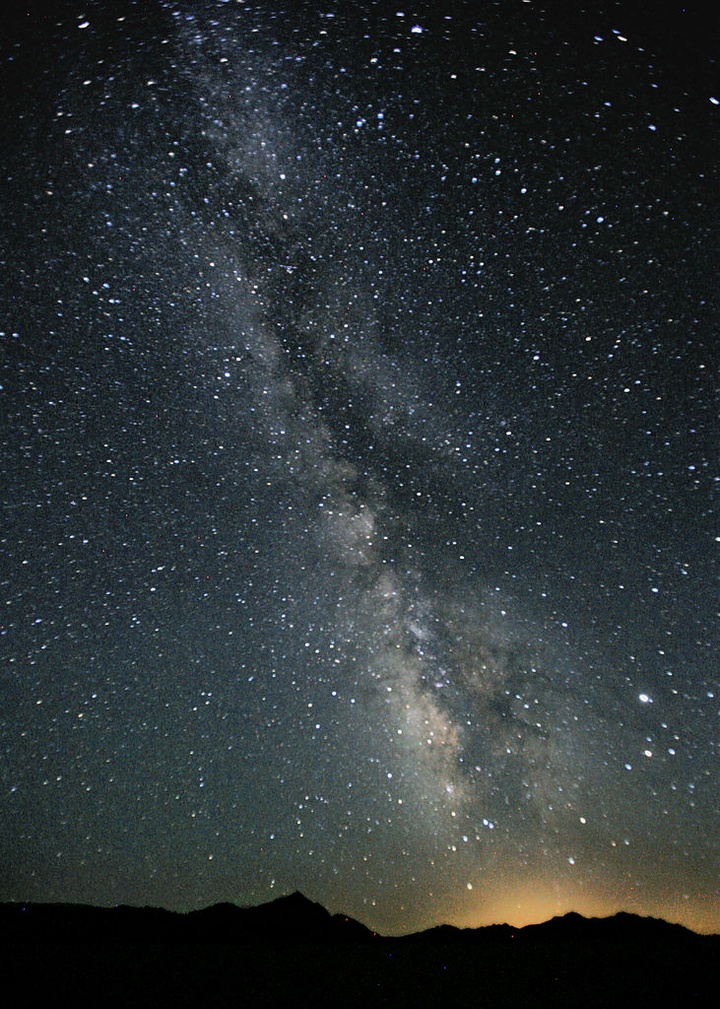
Milky Way from Black Rock Desert, Nevada (Steve Jurvetson, Creative Commons license)
Just
when it’s all starting to get to me — Brexit, Make America Hate
Again, blacks vs. cops, GMOs, anti-vaxxers, Syria, Mr. Robot — I
wake in the middle of the night and stagger out of our tent to pee,
look up and sweetjeezus, lookatthatwillya! The Milky Way, thick and
visceral, straggles down the summer night sky from overhead (Lyra)
down to Sagittarius, half-hidden by the ridge above Paynes Lake. It’s
new moon and the Russian Wilderness is far from city lights, any
lights. I’m gobsmacked, right now in
the universe, not observing it but part
of it, what John Fowles tried to express in The
Collector:
…like lying on one’s back as we did in Spain when we slept out looking up between the fig-branches into the star-corridors, the great seas and oceans of stars. Knowing what it was to be in the universe.
I stood there shivering in my T-shirt, stupidly small in the vast emptiness, listening to the silence, aware of the willow-like Brewer’s spruce we’d camped under. This Milky Way is larger and more luminous than other Milky Ways of my memory. Back in my sleeping bag, Louisa curled up on my shoulder, I stared out the open tent flap, wondering what Babylonians and Egyptians, Greeks and Romans, Byzantines and Venetians, made of this silvery-gray veil half-filling the night sky.
Actually, we know what the ancients thought, they left records. To the Babylonians, the Milky Way was the tail of Tiamat, slain goddess of the ocean; for ancient Egyptians, it was Nut, the sky goddess, as she gave birth to the sun. The Greeks called it a milky circle (γαλαξίας κύκλος, galaxias kyklos) — they imagined milk spurting from Hera’s breast as she suckled Heracles. (The Romans, as usual, followed suit: their via lactea translates directly to our Milky Way.) Aristotle, writing about 330 BC, thought the Milky Way was some sort of upper atmosphere phenomenon, although he acknowledged that the Greek philosopher Anaxagoras had presciently proposed, a century earlier, that what we see may be a blurry view of distant stars. Around 1200 AD, Persian astronomer Nasir a-Din al-Tusi got it more or less right, writing that the Milky Way is “made up of a very large number of small, tightly clustered stars, which, on account of their concentration and smallness, seem to be cloudy patches.”

The Origin of the Milky Way, Jacopo Tintoretto. (Google Art Project, public domain)
Nasir’s guess proved correct four centuries later, in 1610, following the Dutch invention of the telescope. Galilei Galileo pointed his instrument, crafted by his own hands, at the Milky Way and saw…stars! Hundreds and thousands of them, invisible to unassisted human eyes. Like a Seurat painting seen up close for the first time, vague swaths became individual points of light.
But where did we — Earth, sun, solar system — fit in the grand scheme of the galaxy? English astronomer Thomas Wright nailed it, and a little later (1755), so did the great German philosopher Immanual Kant. What we see as the Milky Way, they said, is a huge rotating disk of stars, held together by gravity (like the solar system), which we view sideways on from our vantage point inside the disk.
Which left the problem of blurry un-star-like patches of light which astronomers called “nebulae,” clouds. Might they be other Milky Ways, i.e. other galaxies, really, really far away? Kant thought so, calling them “island universes.” And so it turned out, confirmed by Edwin Hubble’s observations in the 1920s from Mount Wilson. He showed that those fuzzy patches are distant galaxies in their own right; we can even see one without a telescope from Earth’s Northern Hemisphere, the Andromeda Galaxy. (Some “nebulas” really are just that — the glowing gas cloud in Orion’s sword, located nearby in our neighborhood of the Milky Way, is the most obvious example.)

Dawn at Paynes Lake (Barry Evans)
Yeah, I think, we’ve come a long way from Tiamat: everything checks out, more or less, we’ve mapped the universe and our insignificant place in it. Shivers. At 6,500 feet, I’m ready for dawn. By day the world is tangible, absent my galactic angst. But the memory remains two weeks later, and with it something vague and unsettling, put into words by Stephen Weinberg, currently my favorite scientist-writer, Nobel laureate and all-round good guy, who wrote, a quarter-century ago: The more the universe seems comprehensible, the more it also seems pointless.
###
Barry Evans gave the best years of his life to civil engineering, and what thanks did he get? In his dotage, he travels, kayaks, meditates and writes for the Journal and the Humboldt Historian. He sucks at 8 Ball. Buy his Field Notes anthologies at any local bookstore. Please.
CLICK TO MANAGE